First Days of Math Class: Fractions and Equations
A MiddleWeb Blog
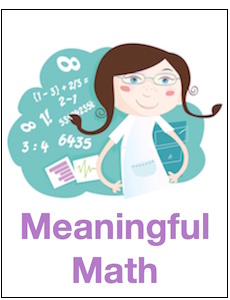 After a wonderful three-week vacation, lots of reading for fun, sleeping late, and going to doctor and dentist appointments that I can’t fit in during the school year, I’m ready to start thinking about the coming school year.
After a wonderful three-week vacation, lots of reading for fun, sleeping late, and going to doctor and dentist appointments that I can’t fit in during the school year, I’m ready to start thinking about the coming school year.
As I begin planning start-of-year activities, I’m reflecting on some of the barriers to my students’ learning in the year just past. In general, my students struggled with two areas: fractions and solving equations. In fact, to some extent, it seems like these two topics are problem areas every year.
Card Sort to Review Fractions
From time to time I think about reviewing fractions at the beginning of the year, but I always talk myself out of it, usually because of time constraints. However, this year I plan to address it specifically in the first weeks and hopefully head off issues in the future.
I have given a lot of thought to why my students struggle so much with fractions, but I’m still not sure I have a good answer. I even hear students say they will skip a problem if it has fractions in it! I’ve wondered if it’s just a shift in societal norms – maybe we just don’t have to think in “fractional ways” so much today? (I do know that students don’t seem to struggle with the idea of decimals the same way they struggle with fractions.)
I think about my husband, who says he’s not good at math, and he is quicker with fractions in his head than I am because measuring is part of his job. My mom, who also says she’s bad at math, can quickly compute fractions in her head because she has practice related to sewing and cooking. I wonder if it’s something that is just not a big part of students’ lives anymore.
Some ideas to scaffold student thinking
I think to help students in this area I will begin with a MAP (Mathematics Assessment Project) lesson: Translating Between Fractions, Decimals, and Percents. (Found here under Grade 6 or jump here.) This activity is a card sort that will require students to “Compare, convert between and order fractions, decimals, and percents.”
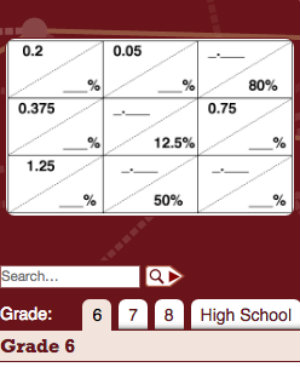
My plan is to do this in the first week of school. It will help me determine what sort of mastery they have with fractions, and it will get them in the habit of working through MAP’s activities, which I plan to implement throughout the year. By doing this activity at the beginning of the year, I hope my students refer back to it throughout the months ahead to help them reason on problems that require them to use fractions.
Playing Games to Help Students Master Equations
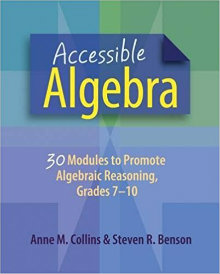
In short, the activity will require each student to fist bump with every other student in the class (purposefully not telling students to count how many fist bumps are exchanged). The students will then be asked to calculate how many fist bumps would be exchanged in a class of 28 students and list and show what strategies they used to come up with an answer. (Check out the activity here.)
I like this activity for several reasons. For one, it lets them practice finding the correct equation to model this situation. In addition, it will give my high school students some foreshadowing regarding quadratics, and in fact I plan to revisit this problem when we begin our unit on quadratic functions. Finally, there are several different ways a student could work this problem, and I believe the students are going to have to work together to arrive at a correct answer.
I think this will be a great activity for the first day. As students exchange fist bumps, they can also exchange names and it will serve as a little meet and greet.
Rules for Solving Equations
I stumbled across a blog post written by Glenn Waddell, My Three Rules of Mathematics. The post dealt with how to use three simple rules to help students solve equations. The post recommended introducing the three rules at the beginning of the year and referring back to them throughout the year. I really liked this idea! However, instead of giving the three rules to my students I plan to let them, as a class, create their own rules for solving equations.
My plan is for students to work with a partner to solve various equations. As they solve the equations, they should be thinking about what steps and processes they are using to correctly solve the equations, and each pair of students will create their rules for solving equations.
At the end of the class, a gallery walk will allow the students to look at each other’s work. To conclude we will come back together and devise a set of rules or procedures for solving equations as a class. I think giving them that extra ownership will make the rules more meaningful to them. I plan to post their rules and keep them up for the entire year for us to refer back to and possibly revise if necessary.
To reinforce these concepts throughout the year, I plan to continue to use my low tech strategy with sticky notes (Not Yet, Almost There, Got It!) along with quizzes, and test questions throughout the year.
If anyone has ideas or suggestions to help students master fractions or solving equations, please share in the comments below!
Feature image: Andertoons.com

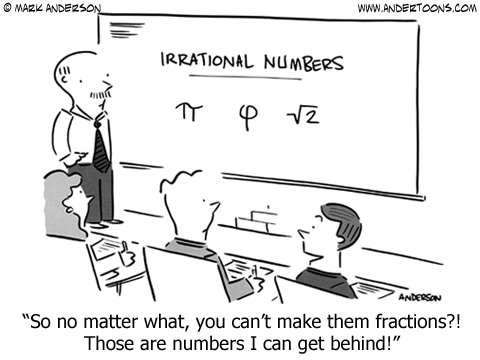
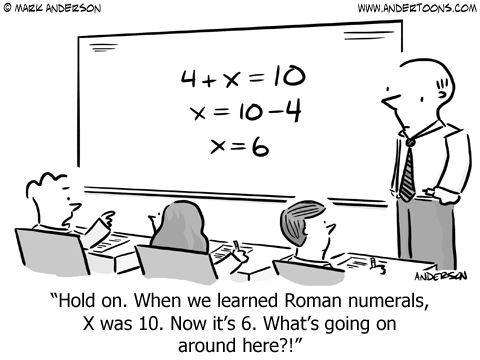
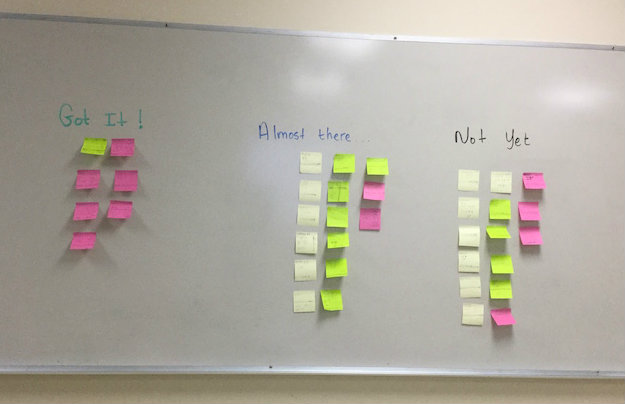



































Michelle,
Thanks for the mention. The only reason to give it to them as I did is that they are also the additive and multiplicative identities. I didn’t want them to have to discover them, since they have been using them forever, just never connected with WHY they were using them.
Keeping solving simple made everyone’s life easy. And, since there really are only three things to think about when solving, making zeros, ones, and consistency, it is actually good mathematical practices too!
I wish great results for your kiddoes too!
Thank you for your comment! Your article was so helpful! I do see your point about directly sharing the three rules with students. I think I was hoping the students would come up with the rules on their own, but it might be better to just to go the more direct route. In any case, thanks again for a great article- I can’t wait to teach solving equations this year!
Hi Michelle,
I have taught Matematics in grades 4-12 for the last 42 years! I have spent the last 4 years as the Mathematics Specialist/Enrichment Faciltator for grades 3-5 in the elementary schools.
I find math games using dice, dominoes, and number lines very effective in reinforcing fraction concepts and operations. The students love the “Pin the Number on the Numberline Game”, which can be used all year to reinforce all topics.
Thank you for comment! I love the idea of using a numberline to teach fractions. I actually Googled “Pin the Number on the Numberline Game” to read more about it and found a great activity to help my students approximate irrational numbers. Thanks for sharing your expertise!
I have used triangle flash cards for years when teaching fractions, decimals, and percents to middle school students. I put the reduced fraction in one angle and the equivalent decimal and percent in the other angles. The game I play with them is called Over the River: 2 teams are in lines, I cover one or two of the angles and ask the student in the front of one line to say the hidden values, if they get it right – they go to the back of their line, if they get it wrong – they go to the back of the other team’s line. The winning team is the one with the most of their original members. The students love it.
The other thing that I do is that I teach fractions as division problems, not just as part of a whole.
Thanks for ideas. I’m subbing in a sixth grade class tomorrow and will be there for about three weeks. I retired from teaching sixth grade in 2005. It’s a lot different now. But I like the number line game idea and will go with it for links to other number lessons.
Good Luck!